Thursday, October 7th, 2021
Differing Views
Officials, lawmakers debate infrastructure spending
By Daily Standard Staff
By WILLIAM KINCAID and LESLIE GARTRELL
newsdept@dailystandard.com
Two U.S. lawmakers from Ohio agree infrastructure is a critical national resource that needs attention, yet they have widely diverging views on the $1 trillion infrastructure bill.
A Mercer County government official and Ball State University professor discussed the need and potential affect of federal infrastructure spending.
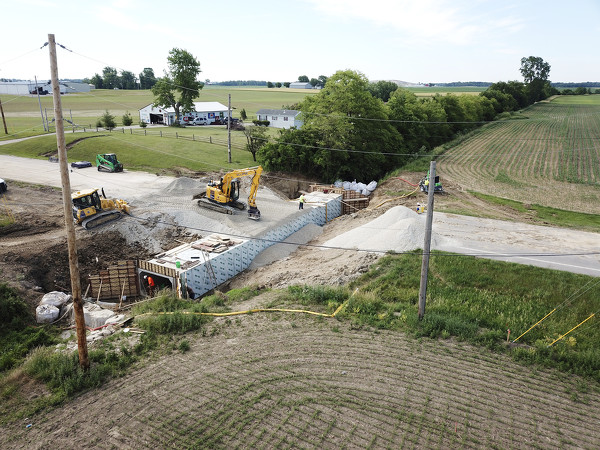
Photo by Ryan Snyder/The Daily Standard
A construction crew installs a new culvert on State Route 219 in Coldwater in this June 15 photo.
Legislators' take
The bipartisan $1 trillion infrastructure bill passed the Senate but has since stalled in the House. It's linked to a larger, 10-year package of social and environmental initiatives that currently stands at $3.5 trillion but likely will end up considerably smaller as Democrats seek to shore up support from moderates in the party, according to the Associated Press.
Top Democrats, AP reported, are now hoping to craft an agreement they can push through Congress by Oct. 31, along with a companion $1 trillion measure financing highway, internet and other infrastructure projects.
Ohio Sen. Sherrod Brown, D, supports the infrastructure bill. His office said the bill is expected to provide Ohio with more than $10 billion of formula funding to repair and replace roads and bridges, upgrade drinking water and sewer systems and update public transit systems.
Brown issued a statement saying, "bridges and roads across Ohio need critical structural repairs - not just for the sake of local safety and accessibility, but also for the local economy."
"The economic potential that investments into infrastructure - like road improvements near the Crossroads project in Cridersville - will unleash economic potential for the region that will pay off for years to come," Brown wrote. "We're going to get this done and we're going to get it done right."
Rep. Bob Latta, R-Bowling Green, in a phone interview emphasized the importance of traditional infrastructure, such as roads and bridges.
"We've got to keep up our infrastructure," Latta said, noting that just about 83% of everything that comes into Ohio is by truck.
"We need our roads and bridges. That's absolutely essential," he said. "It's also essential that we keep up these roads and also constructing new roads."
Yet that's where the two lawmakers' commonality on the issue ends.
Latta contends the bill, according to the last figures he saw, would only set aside 10% of funds for roads and bridges. He said some Democrats don't want to see new bridges and roads built because of the Green New Deal. The Green New Deal seeks to shift the economy away from fossil fuels such as oil and coal and replace them with renewable energy sources such as wind and solar power.
"They don't think they should be building new roads. That's impossible because we've got areas of the country that need roads that need to be constructed or new roads that need to be put in."
Latta argued the bill does not focus enough on traditional infrastructure.
"It's just not all about roads. If we did a roads and bridges package, I think a lot of people would get behind it and support it," he said, noting that the bill, as it now stands, would garner affirmative votes from maybe only 10 Republicans.
Moreover, the proposed package is not a good piece of legislation, he said.
"We sat in Washington literally all day on Friday without Pelosi bringing up the bill," he said. "They're not getting it because of how the progressives want to the tie the two (spending bills) together and some of the other ones don't want to have them tied together."
America can simply not afford such a mammoth spending bill, he said, adding the idea that trillions of dollars in spending is all paid for is one of the biggest lies of the century.
"We're talking about a lot of money being spent, especially when we're hitting the $29 trillion in debt," he said. "We're going to be paying, if this keeps up, a trillion dollars by the end of 2031 just to pay interest on the national debt."
The U.S., he said, owes over $7 trillion in treasuries to foreign countries, "with China and Japan each owning more than a trillion dollars of our debt."
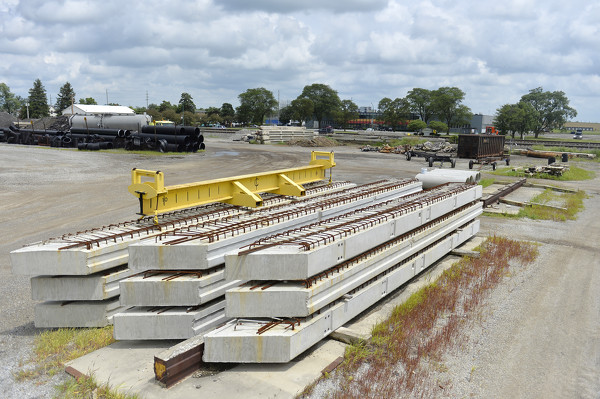
Photo by Dan Melograna/The Daily Standard
Concrete beams wait to be used at the Auglaize County Engineer's Office in Wapakoneta in this July 14 photo.
Good intentions
Jared Ebbing, the county's community development director, concedes infrastructure deserves investment. However, he finds the amount of money unleashed - including the COVID-19-related federal CARES and American Rescue Plan Acts and a state water and wastewater grant program - unnerving.
"The intentions might be good, but when you get that much all at once, are you truly meeting the need, or has it just become a free-for-all?" he asked.
An unnatural injection of that amount of money may upset the systems local leaders have relied on to secure tens of millions of dollars in grants for road, water, wastewater and other infrastructure improvements in Mercer County, he said.
"That doesn't mean that I don't think there's infrastructure projects that are needed. I'm just saying the system that I've been used to working in for 25 years … is now chaotic," he said.
Ebbing works directly with village and city leaders on the Community Development Implementation Strategy board to map out priorities and gain a consensus on which project the county should focus on each year, a strategy that involves using initial funding sources as leverage to secure more state and federal dollars.
It makes more strategic sense to dedicate all allocation funds toward a single project rather than multiple small-scale projects, Ebbing has said.
"It's been a systematic plan," he said. "We meet with the villages. We prioritize our projects. We know what the funding sources are … and we go after them and have been quite successful. We know what the avenues are. We prioritize based upon the right project at the right time. We get the money."
He fears well-established grant and loan funding mechanisms and processes could be upended by the extraordinary influx of new federal and state dollars.
"We get our federal and state tax money back by applying in a smart way," he said, giving the county a grade of B+ on overall infrastructure. "Now it's a shotgun approach and everybody and their brother is going after this money. We already have a pretty good system of going after money."
Ebbing however said it would be foolish not to go after new money streams should they become available. The county would be able to fast-track its systematic approach as many shovel-ready projects exist due to long-term planning. It's just about waiting for the right funding cycle to move ahead, he said.
"We've got to just make sure that we don't lose who we are and our system and our process because money's not worth it in that regard," he said.
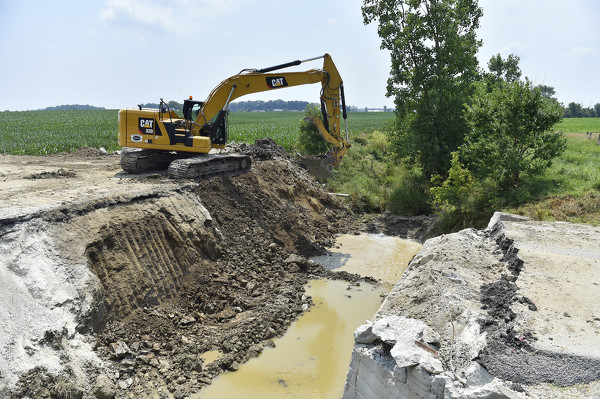
Photo by Dan Melograna/The Daily Standard
A Mercer County crew works to replace a bridge on Siegrist-Jutte Road in this July 6 photo.
Major benefits
Michael Hicks, director of the Center for Business and Economic Research at Ball State University in Muncie, Indiana, said now is the time to invest in long-term infrastructure improvements.
There's a multitude of reasons why, he said.
One such reason is that the country has not had a large-scale infrastructure bill in quite some time.
In addition, the U.S. is a relatively new country compared to other nations, Hicks said. The country's infrastructure hasn't had to be repaired or replaced as often as other, older countries, so the U.S. can be slow to act when it comes to improving infrastructure. Because of that, infrastructure improvements made in the 1950s and 1960s have lived well past their lifespan, he said.
Postponing infrastructure improvements can come at the cost of citizens' health, Hicks argued. From contaminated water systems to fewer health care options because of a lack of telemedicine, delaying infrastructure investments can have real effects on people's health, he said.
Infrastructure delays also have real-world costs, Hicks said. Constant repairs and maintenance costs, school or work closures because of building failures, power outages and other infrastructure-related issues all cost money, Hicks contended.
However, Hicks said the best argument for large-scale spending on infrastructure now is because of historically low U.S. borrowing rates.
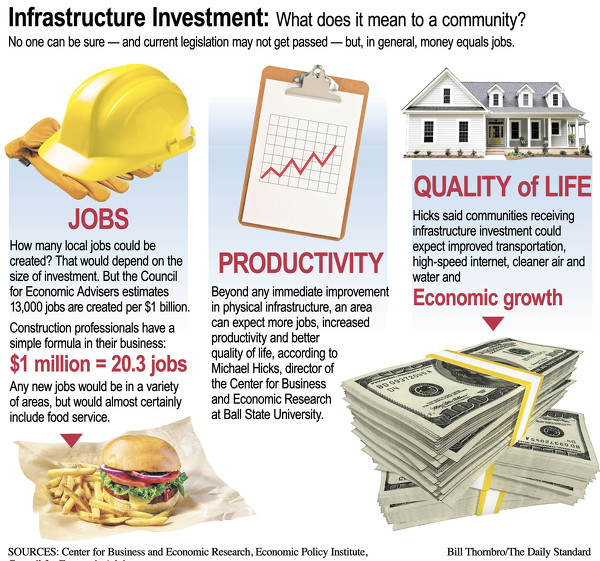
Photo by Bill Thornbro/The Daily Standard
Infrastructure Investment
"The United States today can borrow money at almost no interest - really negative interest, or real interest when you count for inflation. And so there's never been a better time for the federal government to borrow in the wake of this pandemic," Hicks said. "Because the repayment costs are very low, the benefits that would likely flow from infrastructure investment now are pretty likely to be high relative to the cost, because we're not paying three or four percent (interest) to do the building today."
Other than the infrastructure improvements themselves, Hicks said there are three benefits of investing in improved infrastructure - job creation, improved quality of life and productivity.
In the short term, improving infrastructure will create jobs at the local level, Hicks said. Whether it be contractors, construction workers or tradespeople, Hicks said more workers will be necessary to implement the infrastructure improvements President Joe Biden is advocating for.
Hicks argued that one of the major benefits of infrastructure spending is the improved quality of life. When people can access transportation, high-speed internet, clean air and drinking water and other infrastructure improvements, Hicks believes people are happier and healthier. And when people are happy and healthy, there is a strong chance they will be more productive.
For residents in smaller, more rural areas such as Mercer and Auglaize counties, Hicks said it may be time to consider investing in infrastructure, not just for the jobs or the economy, but also to bring new growth, opportunity and improved quality of life to the area's residents.
"The (high school graduates) who went to college elsewhere and are just dying to move back to your county, could they afford to do so and work from home? Do you have the broadband to support it?" he posed as an example. "There's a lot of people that want to live in (small towns), but they don't want to give up the stuff they had in college or in their military service elsewhere. If (a) small town can't compete with those things, they're going to find themselves shut out of an opportunity that might otherwise have been available."
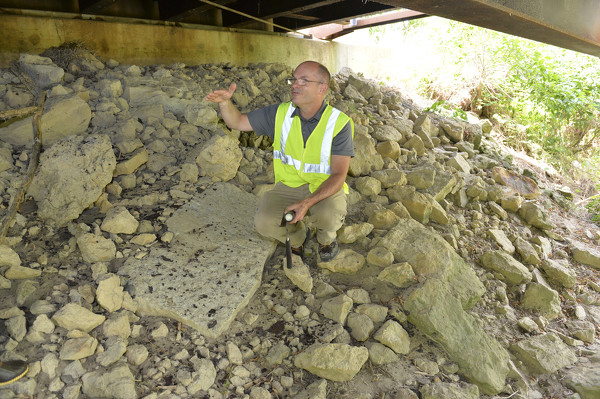
Photo by Dan Melograna/The Daily Standard
Mercer County engineer Jim Wiechart crouches under a bridge over the Wabash River near Fort Recovery in this June 23 photo.
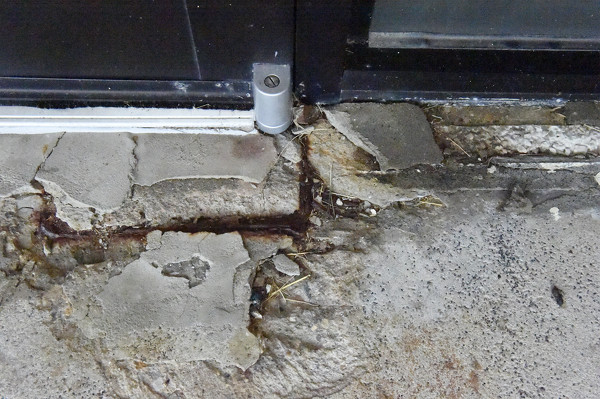
Photo by Dan Melograna/The Daily Standard
The concrete in front of this door at the Celina Primary School is cracked and deteriorated.
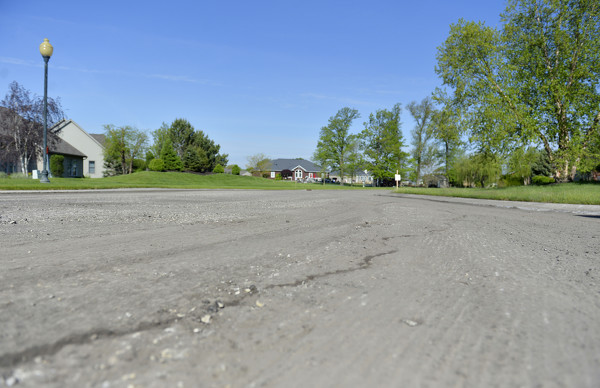
Photo by Dan Melograna/The Daily Standard
Irmscher Boulevard in Celina has been prepared for repaving in this May 19 photo.










